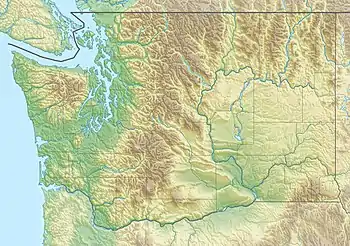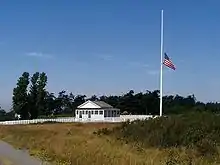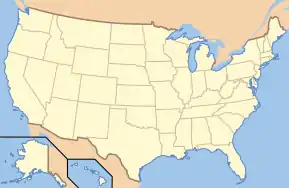San Juan Island National Historical Park
San Juan Island National Historical Park, also known as American and English Camps, San Juan Island, is a U.S. National Historical Park owned and operated by the National Park Service on San Juan Island in the state of Washington. The park is made up of the sites of the British and U.S. Army camps during the Pig War, a boundary dispute over the ownership of the island. Both of these camps were set up in 1859 as response to a border controversy triggered by the killing of a pig. The camps were occupied for 12 years, until the islands were awarded to the United States by Kaiser Wilhelm I in an arbitration agreed by the parties in the 1872 Treaty of Washington. The British abandoned their camp in November 1872, while the American camp was disbanded in July 1874.[5] The camp sites were designated a National Historic Landmark in 1961,[4] and listed on the National Register of Historic Places in 1966.[6] The park was created by an Act of Congress in 1966.
| San Juan Island National Historical Park | |
|---|---|
IUCN category V (protected landscape/seascape) | |
 British Camp | |
  | |
| Location | San Juan County, Washington, USA |
| Nearest city | Friday Harbor, Washington |
| Coordinates | 48°27′21″N 122°59′08″W |
| Area | 2,072 acres (8.39 km2)[1] |
| Authorized | September 9, 1966[2] |
| Visitors | 266,717 (in 2011)[3] |
| Governing body | National Park Service |
| Website | San Juan Island National Historical Park |
| Designated | November 5, 1961[4] |
| Designated | October 15, 1966 |
Setting and historical context
San Juan Island is located in Puget Sound, the westernmost of the main islands of the San Juan Islands group. This island group is separated from Vancouver Island (part of British Columbia in Canada) by the Haro Strait, and from the Washington mainland by the Rosario Strait. These two channels defined the competing territorial claims of the United States and Great Britain after the Oregon Treaty of 1846 settled most of the northwestern border.[7]
Both sides pursued their territorial claims, with Americans homesteading on San Juan Island, and the British Hudson's Bay Company establishing a farm on the southern tip of the island. In 1859, an American killed a stray British-owned pig, sparking the international dispute known as the Pig War. The American homesteaders requested military protection, resulting in the establishment of the American camp, while the British sent Royal Navy ships. Cooler heads prevailed, and an agreement was reached whereby both sides would maintain camps on the island until the dispute could be resolved through diplomacy. From 1860 to 1872, British Royal Marines occupied a camp on the northwestern part of the island.[8]
The period of military occupation was peaceful; a road was built between the two camps, and Americans in the village of San Juan engaged in commerce with both encampments. In 1871, the two countries negotiated the Treaty of Washington, in which the matter of the islands was to arbitrated by the German Kaiser. His decision the following year declared the boundary to be the Haro Strait, thus awarding the islands to the United States.[7]
The British withdrew from their camp soon after, and the American camp was reduced in size and scope. The buildings and properties were sold as surplus or abandoned. The British camp was homesteaded in 1876 by William Crook, a farmer and carpenter, whose son built a house in the camp area in the early 20th century. The Crooks donated their property to the state beginning in the 1950s, and the state also acquired land around the American camp beginning in 1951. These properties formed the core what became this park in 1966.[7][8]
British Camp
The British Camp site is on Garrison Bay on the islands northwestern shore. Today the Union Jack still flies there, being raised and lowered daily by park rangers, making it one of the very few places without diplomatic status where US government employees regularly hoist the flag of another country. Surviving buildings from the British occupation include a commissary, barracks, blockhouse, and hospital; the latter building was one that was sold and moved from the site, but was later acquired by the park and returned.[8]
American Camp
The American Camp site is on the islands southernmost peninsula, and partially overlaps the original Hudson's Bay Company farm. The park property also includes the original site of San Juan village on the north shore of the peninsula, which was abandoned after the dispute ended and was entirely burned in 1890. The camp site includes two surviving buildings from the American military occupation: an officers' quarters, and the house and working quarters of the camp laundress.[7]
 American Camp
American Camp Officer's Quarters
Officer's Quarters
References
| Wikimedia Commons has media related to San Juan Island National Historical Park. |
- "Listing of acreage as of December 31, 2011". Land Resource Division, National Park Service. Retrieved 2012-03-19.
- "The National Parks: Index 2009–2011". National Park Service. Retrieved 2012-03-19.
- "NPS Annual Recreation Visits Report". National Park Service. Retrieved 2012-03-19.
- "American and English Camps, San Juan Island". National Historic Landmark summary listing. National Park Service. Archived from the original on 2008-01-30. Retrieved 2008-03-01.
- "San Juan Island National Historical Park". Retrieved 2008-02-27.
- "National Register Information System". National Register of Historic Places. National Park Service. July 9, 2010.
- "Cultural Landscape Inventory for American Camp, San Juan National Historical Park" (PDF). National Park Service. Retrieved 2017-04-18.
- "Cultural Landscape Inventory for British Camp, San Juan National Historical Park" (PDF). National Park Service. Retrieved 2017-04-18.
